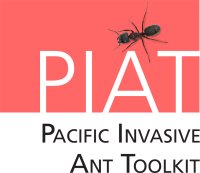Red imported fire ant
|
bites |
stings |
harms crops |
harms people |
harms wildlife |
lives on ground |
day active |
different sizes |
|
Red imported fire ant worker (© Mario David Bazan, Creative Commons License) |
 Red imported fire ant mound (© Alex Wild) |
|
Scientific name: Solenopsis invicta Size: 2-6 mm Colour: reddish-brown, black gaster General description: workers come in a large range of sizes (polymorphic). These ants are very aggressive and will bite and sting when disturbed. They may also make large mounds up to 40 cm high with no apparent openings in the top. It can be difficult to identify the difference between red imported fire ants and tropical fire ants. Red imported fire ants are much more aggressive their stings are more painful and result in blisters after 24 hours. Habitat and nesting: the red imported fire ant is a ground dwelling species that builds it nests in mounds of earth up to 46 cm diameter in open pasture. In urban environments, the ant may nest under concrete foundations, paving, driveways or slabs. The ants’ excavations beneath such concrete slabs may cause them to sink or collapse causing damage. The ants have also been found nesting in electrical boxes. During periods of heavy rain, the ants may abandon their nests to seek higher ground, which may include movement into homes and other buildings. Rate of spread: 10-40 m/year in Texas. Distribution: see our invasive ant distributions page for the worldwide distribution of the red imported fire ant. |
Red imported fire ant workers come in a large range of sizes (© Dini Miller, Virginia Cooperative Extension, Virginia Tech, and Virginia State University)
Red imported fire ant biting and stinging (© Alex Wild) |
||
|
Global distribution of the red imported fire ant (© Pacific Biosecurity) |
Reproduction: red imported fire ants are a bit different from most other species of invasive ants. They can form two types of colony, technically called polygyne (many queens) or monogyne (one queen).
Because polygyne colonies have multiple queens they are the most harmful form of colony. These colonies spread mostly by budding, like the other "worst 5". Sometimes mating flights can occur but they do not fly far.
Monogyne colonies have a single queen and live in only one nest. They have mating flights, where new queens fly up to 2 km from the nest they were born in to form new colonies. These mating flights make the monogyne form of the red imported fire ant much more difficult to contain.
Development: red imported fire ants have one of the quickest development times of the worst 5 invasive ants. Eggs hatch into larvae in 6-10 days. Larvae take 12-14 days to develop into pupae. The pupae develop for 9-16 days, after which adults emerge.
 A winged red imported fire ant queen preparing to fly away to begin a new colony. Queens can build new colonies up to 2 km away from the nest where they were born (© Johnny N. Dell, BugwoodWiki) |
For detailed descriptions and identification of the red imported fire ant please see:
PIAkey: Solenopsis invicta (see diagnostic characters tab) |
Impacts of the red imported fire ant

Fire ant stings are extremely painful (© State of New South Wales through NSW Department of Industry) SocialThese ants are well known for their extremely painful sting, which may cause a severe allergic reaction (anaphylactic shock) in some people. This species can make parks, beaches and other public areas they inhabit unusable and unsafe for children. Millions of people are stung every year in the United States, and about 1% of those stung require medical attention due to an allergic reaction. AgriculturalRed imported fire ants collect and eat seeds and may attack fruits, new shoots and roots of plants, reducing crop yield. Their painful sting makes harvesting some crops difficult as well. In China some rice paddies and orchards have been abandoned altogether due to these stinging pests. The nest mounds they build may interfere with farm equipment. EnvironmentalRed imported fire ants appear to be responsible for the decline of many bird, reptile, amphibian and small mammal species, as well as many invertebrate species. |
Red imported fire ants foraging on peanut butter in North Carolina, Vimeo video (© Eli Sarnat, Creative Commons Attribution, Share Alike CC BY-SA Licence)
Red imported fire ants can prevent pollinators from visiting crops (© Phil Lester) |
Management
If you are interested in getting rid of red imported fire ants, check out the treatment options for this species, or look at management programme case studies to see examples of other control programmes that target them.
Information sources
Bugwood Wiki, Red imported fire ant
Dhami, Booth. 2008. Review of dispersal distances and landing site behaviour of Solenopsis invicta Buren, Red Imported Fire Ant (RIFA). Unpublished report for MAFBNZ, Wellington, New Zealand
Global Invasive Species Database, Red imported fire ant
Global Register of Introduced and Invasive Species (GRIIS)
Holway, Lach, Suarez, Tsutsui and Case. 2002. The causes and consequences of ant invasions. Annual Review of Ecology, Evolution, and Systematics 33: 181-233
University of Florida webpage, Red imported fire ant
USDA-APHIS webpage, Red imported fire ant resources
Xtension.org Red imported fire ant resources
Wylie, Janssen-May. 2017. Red imported fire ant in Australia: what if we lose the war? Ecological Management & Restoration 18(1): 32-44





